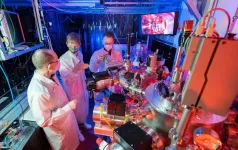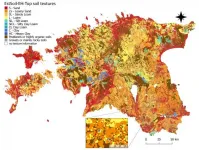A sharper look at the interior of semiconductors
A high-resolution imaging technique can be used to investigate materials in a non-destructive manner and with nanometer precision
2021-02-16
(Press-News.org) Images provide information - what we can observe with our own eyes enables us to understand. Constantly expanding the field of perception into dimensions that are initially hidden from the naked eye, drives science forward. Today, increasingly powerful microscopes let us see into the cells and tissues of living organisms, into the world of microorganisms as well as into inanimate nature. But even the best microscopes have their limits. "To be able to observe structures and processes down to the nanoscale level and below, we need new methods and technologies," says Dr Silvio Fuchs from the Institute of Optics and Quantum Electronics at the University of Jena. This applies in particular to technological areas such as materials research or data processing. "These days, electronic components, computer chips or circuits are becoming increasingly small," adds Fuchs. Together with colleagues, he has now developed a method that makes it possible to display and study such tiny, complex structures and even "see inside" them without destroying them. In the current issue of the scientific journal "Optica", the researchers present their method - Coherence Tomography with Extreme Ultraviolet Light (XCT for short) - and show its potential in research and application.
Light penetrates the sample and is reflected by internal structures
The imaging procedure is based on optical coherence tomography (OCT), which has been established in ophthalmology for a number of years, explains doctoral candidate Felix Wiesner, the lead author of the study. "These devices have been developed to examine the retina of the eye non-invasively, layer by layer, to create 3-dimensional images." At the ophthalmologist, OCT uses infrared light to illuminate the retina. The radiation is selected in such a way that the tissue to be examined does not absorb it too strongly and it can be reflected by the inner structures. However, the physicists in Jena use extremely short-wave UV light instead of long-wave infrared light for their OCT. "This is due to the size of the structures we want to image," says Felix Wiesner. In order to look into semiconductor materials with structure sizes of only a few nanometres, light with a wavelength of only a few nanometres is needed.
Nonlinear optical effect generates coherent extremely short-wave UV light
Generating such extremely short-wave UV light (XUV) used to be a challenge and was almost only possible in large-scale research facilities. Jena physicists, however, generate broadband XUV in an ordinary laboratory and use what are called high harmonics for this purpose. This is radiation that is produced by the interaction of laser light with a medium and it has a frequency many times that of the original light. The higher the harmonic order, the shorter the resulting wavelength. "In this way, we generate light with a wavelength of between 10 and 80 nanometres using infrared lasers," explains Prof. Gerhard Paulus, Professor of Nonlinear Optics at the University of Jena. "Like the irradiated laser light, the resulting broadband XUV light is also coherent, which means that it has laser-like properties."
In the work described in their current paper, the physicists exposed nanoscopic layer structures in silicon to the coherent XUV radiation and analysed the reflected light. The silicon samples contained thin layers of other metals, such as titanium or silver, at different depths. Because these materials have different reflective properties from the silicon, they can be detected in the reflected radiation. The method is so precise that not only can the deep structure of the tiny samples be displayed with nanometre accuracy, but - due to the differing reflective behaviour - the chemical composition of the samples can also be determined precisely and, above all, in a non-destructive manner. "This makes coherence tomography an interesting application for inspecting semiconductors, solar cells or multilayer optical components," says Paulus. It could be used for quality control in the manufacturing process of such nanomaterials, to detect internal defects or chemical impurities.
INFORMATION:
Original publication:
Wiesner F. et al. Material-specific imaging of nanolayers using extreme ultraviolet coherence tomography, Optica (2021), https://www.osapublishing.org/optica/fulltext.cfm?uri=optica-8-2-230&id=447633
Contact:
Dr Silvio Fuchs, Prof. Gerhard G. Paulus
Institute of Optics and Quantum Electronics of Friedrich Schiller University Jena
Max-Wien-Platz 1, 07743 Jena, Germany
Tel.: +49 (0)3641 / 947629, +49 (0)3641 / 947201
E-mail: silvio.fuchs@uni-jena.de, gerhard.paulus@uni-jena.de
[Attachments] See images for this press release:

ELSE PRESS RELEASES FROM THIS DATE:
2021-02-16
A recent qualitative study sheds light on how people cope with health and financial challenges, highlighting the important role that communication plays in these coping strategies.
"This is one of the first studies to look at how people respond to the combination of financial uncertainties and health uncertainties," says Lynsey Romo, first author of the study and an associate professor of communication at North Carolina State University. "And it drives home that uncertainty about money and uncertainty about health go hand in hand. Financial limitations created significant health challenges - such as an inability to afford prescription medications. And health problems created significant expenses leading to serious financial challenges.
"The study also highlights that these ...
2021-02-16
A comprehensive database of Estonian soils and a map application has been completed in cooperation with researchers of the University of Tartu and the Estonian University of Life Sciences. The database makes Estonian soil information easily accessible and can be used from local farm-scale to national-level big data statistical analysis and machine-learning models.
"Soil data is possibly the most undervalued and yet complicated type of environmental data there is. The diversity of organic, chemical, living and dead materials that make up a handful of dirt is astounding," said Alexander Kmoch, ...
2021-02-16
BINGHAMTON, NY -- Rich nations should not engage in "vaccine nationalism" and keep the COVID-19 vaccine to themselves when poorer nations need them, according to Nicole Hassoun, professor of philosophy at Binghamton University, State University of New York. Hassoun's paper, "Against Vaccine Nationalism," was published in the Journal of Medical Ethics.
While rich countries like the US and UK are starting to vaccinate their populations against COVID-19, poor countries may lack access to a vaccine for years. Canada, for instance, has already secured enough to vaccinate its entire population nine times over, and the US, European Union, UK, Australia, and Japan can vaccinate their populations between 2-8x.
"Vaccine nationalism ...
2021-02-16
Globalization, digitalization, sustainabilization - three major waves of transformation are unfolding around the world. The social upheaval caused by these transformation processes has given rise to populist movements that endanger social harmony and threaten democratic values. What rules and institutions can promote stability in the face of such systemic risks? A new study published by the Institute for Advanced Sustainability Studies (IASS) offers some surprising answers.
The coronavirus pandemic has demonstrated for the first time how a systemic risk can sweep across our globalized world. It began with the little-noticed outbreak of an unknown ...
2021-02-16
The lithium-ion battery powers everything from mobile phones to laptops to electric vehicles. Scientists worldwide are always on the hunt for new and improved components to build better batteries for these and other applications.
Scientists from the U.S. Department of Energy's (DOE) Argonne National Laboratory report a new electrode design for the lithium-ion battery using the low-cost materials lead as well as carbon. Contributors to this pivotal discovery also include scientists from Northwestern University, Brookhaven National Laboratory and the Ulsan National Institute of Science and Technology (UNIST).
"Our new anode could offer a new revenue stream for the large industry currently engaged in lead-acid battery ...
2021-02-16
By Maria Fernanda Ziegler | Agência FAPESP – The use of cover crops between cotton harvests protects the soil, conserves water, and reduces the risk of erosion. Researchers at the University of Western São Paulo (UNOESTE) and São Paulo State University (UNESP) in Brazil found that application of potassium (K) to a grass cover crop grown before cotton in sandy soil lowered production cost and resulted in cotton with a higher market value.
“The dynamics of early application of potassium to grass planted as a cover crop before cotton ...
2021-02-16
Crocodiles are resilient animals from a lineage that has survived for over 200 million years. Skilled swimmers, crocodiles can travel long distances and live in freshwater to marine environments. But they can't roam far overland. American crocodiles (Crocodylus acutus) are found in the Caribbean and Pacific coasts of the Neotropics but they arrived in the Pacific before Panama existed, according to researchers from McGill University.
Over 3 million years ago, the formation of the Isthmus of Panama altered global ocean circulation, connecting North and South America and establishing the Caribbean Sea. This resulted in widespread mixing of species ...
2021-02-16
Scientists at the Center for Infection and Immunity (CII) at Columbia University Mailman School of Public Health and SunYat-Sen University in China have set the stage for the development of highly sensitive antibody tests for infection with all known human coronaviruses, including new variants of SARS-CoV-2. These tests should also allow differentiation of immune responses due to infection and vaccination. The research is published in Communications Biology, a Nature journal.
The HCoV-Peptide array developed by CII scientists consists of 3 million immune markers on a glass chip, ...
2021-02-16
INDIANAPOLIS--Researchers from Indiana University have identified key genetic changes in the interstitial kidney tissue of people with diabetes, a discovery that signifies the potential for a revolutionary new genetic approach to the treatment of kidney disease. They will contribute their findings to the Kidney Precision Medicine Project's (KPMP) "cell atlas," a set of maps used to classify and locate different cell types and structures within the kidney.
They shared their groundbreaking findings in a study published on February 10, 2021, in Science Advances.
In the study, researchers investigated the kidney tissue of healthy people and people with diabetes using a technique called "regional transcriptomics." This technique involves a rapid ...
2021-02-16
The COVID-19 infection rate among pregnant women was estimated to be 70% higher than in similarly aged adults in Washington state, according to a new study published today in American Journal of Obstetrics and Gynecology. Other key findings include:
The study also showed that the number of COVID-19 infections in pregnant patients from nearly all communities of color in Washington was high. There was a twofold to fourfold higher prevalence of pregnant patients with COVID-19 infections from communities of color than expected based on the race-ethnicity distribution of pregnant women in Washington in 2018.
A high number of pregnant women with COVID-19 received ...
LAST 30 PRESS RELEASES:
[Press-News.org] A sharper look at the interior of semiconductors
A high-resolution imaging technique can be used to investigate materials in a non-destructive manner and with nanometer precision




